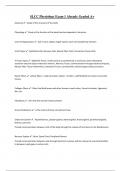SLCC Physiology Exam 1 Already Graded A+
Anatomy ✔️Study of the structure of the body
Physiology ✔️Study of the function of the body-function depends of structure
Level of Organization ✔️Cell, Tissue, Organ, Organ System-each cell classified by function
4 Cell Types ✔️Epithelial Cells, Nervous Cells, Muscle Fiber Cells, Connective Tissue Cells.
4 Tissue Types ✔️Epithelial Tissue: inside and out is protected by a continuous layer-absorption
secretion-exocrine ducts-endocrine internal , Nervous Tissue: communication through electrical impulse,
Muscle Fiber Tissue: Movement, Connective Tissue: connect/link, anchor/support body structures
Elastic Fibers ✔️yellow fibers ; made of protein elastin ; stretchy ; add flexibility to certain connective
tissues
Collagen Fibers ✔️Fiber that Bind bones and other tissues to each other; Found in tendon, ligaments,
skin, etc
Fibroblasts ✔️Are cells that secrete matrix proteins
Ground Substance ✔️Is the matrix of loose connective tissue
Endocrine System ✔️Hypothalamus, pituitary gland, adrenal gland, thyroid gland, parathyroid gland,
thymus, pancreas
Provide communication between cells of the body through the release of hormones in the bloodstream
Nervous System ✔️Brain, Spinal Cord, Peripheral Nerves
Provide communication between cells through electrical in pluses and the release of neurotransmitters
in between small gaps in certain cells
, Musculoskeletal System ✔️Skeletal Muscles, bones, tendons and ligaments
Support the body; allow voluntary movement of the body and facial expression.
Cardiovascular System ✔️Heart, Blood vessels, blood
Transport molecules throughout the body in the bloodstream
Respiratory System ✔️Lungs, pharynx, Trachea, Bronchi
Bring oxygen into the body and expel carbon dioxide from the body
Urinary System ✔️Kidneys, ureters, Urinary bladder, urethra
Filters blood to regulate the acidity, blood volume, and ion concentration; eliminates wastes
Gastrointestinal System ✔️Mouth, esophagus, stomach, small intestines, large intestine, liver,
pancreas, gall bladder
Break down food and absorb it into the body-lumens are external
Reproductive System ✔️Gonads, reproductive tracts and glands
Generate offspring
Immune System ✔️White blood cells, Thymus, Lymph Nodes, Spleen, tonsils, adenoids
Defend the body agains pathogens and abnormal cells
Integumentary System ✔️Skin
Protects the body from the external enviroment
Membrane Potential ✔️the difference in electrical potential or voltage across the cell membrane




